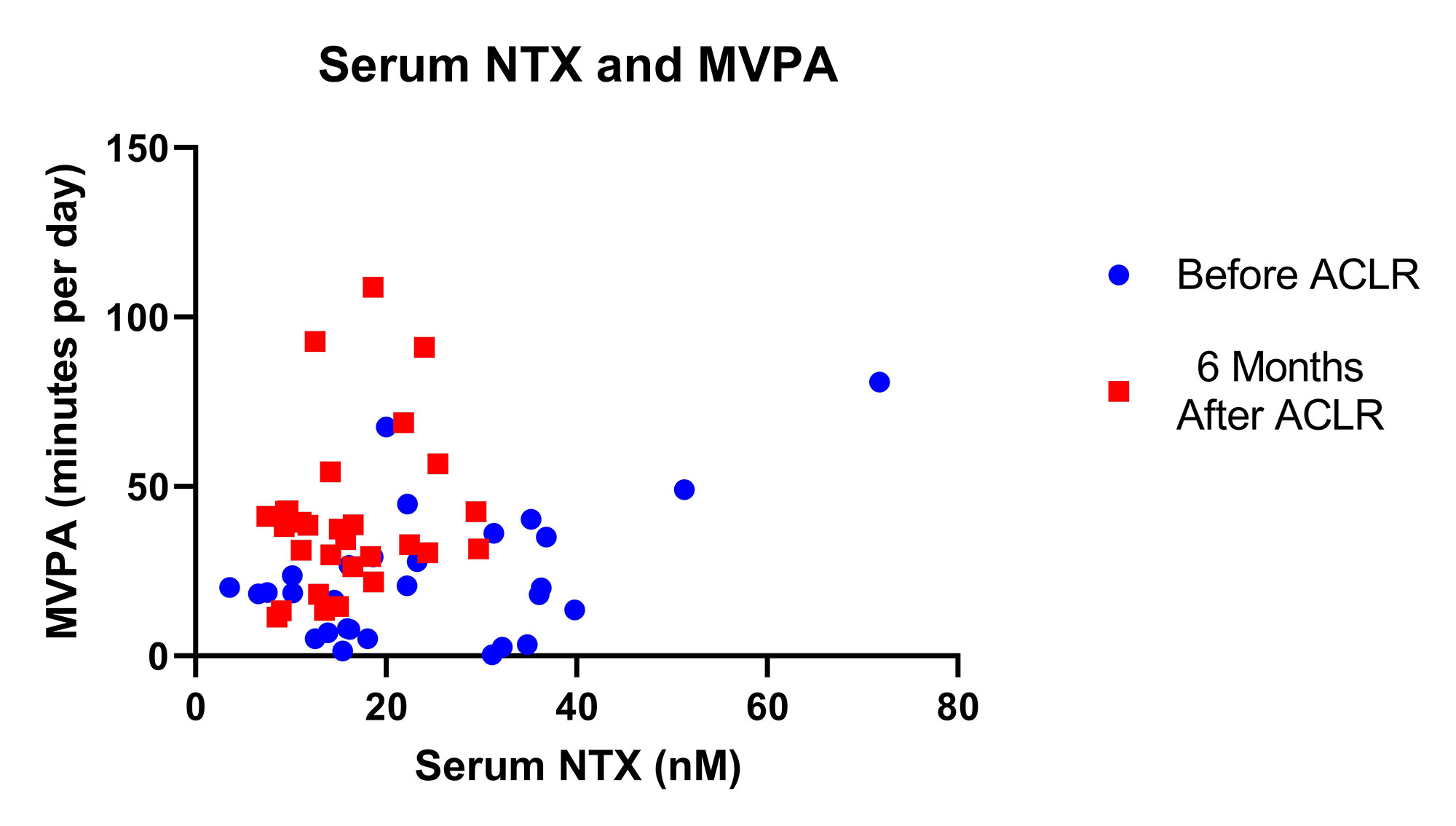Session Information
Session Type: Poster Session B
Session Time: 9:00AM-10:30AM
Background/Purpose: Individuals after anterior cruciate ligament reconstruction (ACLR) have 8 times higher odds of developing knee osteoarthritis (OA) within 10 years compared to those with uninjured knees. Knee OA commonly affects cartilage, synovium, menisci, and bone. The course of bone changes over time after ACLR is not well established, particularly in relation to physical activity (PA) levels that can affect bone health. N-terminal telopeptide (NTX) is a biomarker that measures the rate of bone turnover, specifically bone resorption. Our previous work indicates the trajectory of PA after ACLR is not linear and highly variable. Therefore, the purpose of this study was to describe relationships between NTX levels before and 6 months after ACLR and to determine if NTX levels correlate with PA levels during this time period. We hypothesized that NTX levels would be lower at 6 months after ACLR and that higher NTX levels would correlate with higher PA levels.
Methods: Twenty-nine ACL-injured participants (15-35 years old) without chondral lesions, concomitant grade III tear to other knee ligaments, or previous knee injury were included. Serum samples collected from the antecubital vein and PA were collected before ACLR (within 1 month of injury) and 6 months after ACLR. Synovial fluid (SynF) was collected intraoperatively from the injured knee immediately prior to ACLR. NTX was measured by enzyme-linked immunosorbent assays. PA was measured using a 3-axis accelerometer (Actigraph wGT3X-BT) worn at the right iliac crest during the waking hours for 1 week. At least 4 days with at least 10 hours of daily wear was required to calculate percent time in sedentary activity, daily minutes of moderate to vigorous PA (MVPA), and daily steps. Paired t-tests were used to compare serum NTX and PA levels before and 6 months after ACLR. Pearson correlations were used to compare NTX and PA levels.
Results: Participants were 19.2±4.8 years old and 62.1% female, BMI was 25.2±4.7 kg/m2, and 51.7% had concomitant meniscus repair during ACLR. Serum NTX (p< 0.001) and percent sedentary time (p=0.006) were lower at 6 months after ACLR compared to before ACLR (p< 0.001) while MVPA (p=0.002) and daily steps (p=0.003) were higher (Table 1). Among the 18 (62.1%) participants with available SynF samples, serum NTX before ACLR (23.6±11.4 nM) was strongly correlated with SynF NTX (22.0±8.5 nM) at ACLR (r: 0.824; p< 0.001). Before ACLR, higher levels of serum NTX were correlated with greater minutes of MVPA (r: 0.504; p=0.005) (Figure 1) but not sedentary time (r: 0.087; p=0.731) or daily steps (r: 0.297; p=0.118). At 6 months after ACLR, serum NTX was not correlated with any PA marker (all p >0.05).
Conclusion: Serum NTX levels decreased from early after ACL injury to 6 months after ACLR. Serum NTX levels before ACLR were positively correlated to higher levels of MVPA. Mixed evidence exists regarding whether greater levels of bone resorption represent the occurrence of degenerative processes or healthier levels of joint metabolism that may be protective against OA development. Our future work will explore bone imaging and additional cartilage and inflammatory biomarkers to further investigate their roles with PA in early knee OA after ACL injury.
To cite this abstract in AMA style:
Wellsandt E, Werner D, McKee M, Tao M, Michaud K, Golightly Y. Bone Turnover and Physical Activity Before and After Anterior Cruciate Ligament Reconstruction [abstract]. Arthritis Rheumatol. 2022; 74 (suppl 9). https://acrabstracts.org/abstract/bone-turnover-and-physical-activity-before-and-after-anterior-cruciate-ligament-reconstruction/. Accessed .« Back to ACR Convergence 2022
ACR Meeting Abstracts - https://acrabstracts.org/abstract/bone-turnover-and-physical-activity-before-and-after-anterior-cruciate-ligament-reconstruction/


